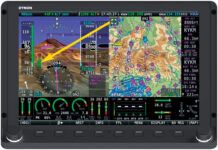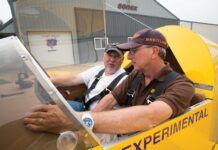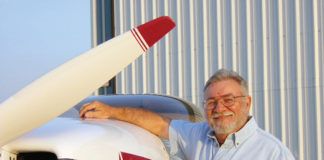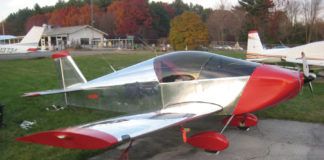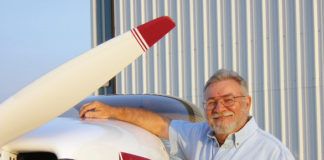Polly Ranch, the airpark where we have been living for a couple of years, is a fascinating place to land. The runway started out as a gravel strip on a small hobby ranch several miles outside of the village of Friendswood, Texas, back in the 1950s. Urban sprawl being what it is, the ranch was eventually subdivided and sold as an airpark community out on the edge of town.
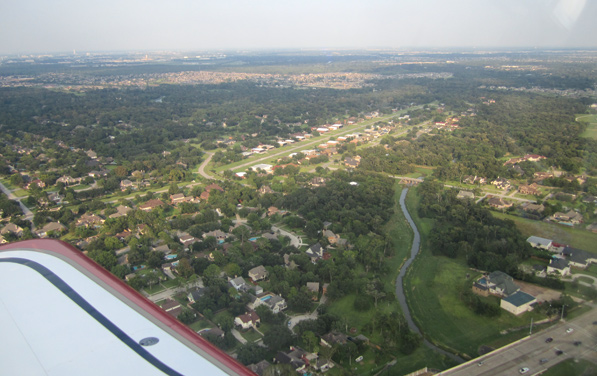
Polly Ranch Airpark, Friendswood, Texas. It used to be alone in the country, but now it is surrounded by neighborhoods.
Today, it is mostly surrounded by newly constructed homes in fancy subdivisions with names like Eagles Landing and Rancho Viejo. I guess the folks with horses like the rancho, but I am still looking for the eagles. Aside from the fear that the new neighbors will eventually rise up and wish to oust the noisy airport (that was there long before they even thought of buying a lot on the former coastal prairie), our biggest worry is where to go if the engine fails on takeoff. The open rice fields we used to have in every direction now host streets, houses and playgrounds with kids. The creek that winds through the area looks safer for everyone but us pilots!
With a paved surface just 22 feet wide and 3000 feet long (displaced thresholds make it 2700 feet usable), Polly is plenty long, but visually a bit challenging to those not used to landing on pavement narrower than their wingspan. Its plenty wide for our 8-foot gear spread.
But try telling that to yourself when the wind is blowing crosswise, and alternately being blocked by houses and hangars as you roll down the runway. Obviously, you can get used to anything, but we are cautious about who we invite as first-time visitors. The fact that the shoulders are really only about 20 feet of grass on each side with a ditch and then hangars makes it more sporting yet.
Now Try That at Night!
One beautiful winter night, I was coming back from dinner up in College Station with my wife, Louise. (She works up there, commuting in her RV-6, and sometimes spends a few days in a row at her crash pad/condo.) The moon was 5% waxing. In other words, the little sliver that was visible set about an hour after the sun went down. This made for a spectacularly dark night sky with lots of city lights to enjoy on the 32-minute trip home. The lights got brighter and more numerous as I approached Houston and flew over the western precincts, and then started to get dimmer as I moved out into the southern suburbs.
Polly Ranch at night is also interesting in that it is surrounded by all those new developments I mentioned-midrange homes on large lots with just enough lights in the trees to make our runway blend into the background.
With the clear space for the runway only about 80 feet wide, and trees in most back yards, the dozen or so runway lights on each side are visible as long as you are lined up with the centerline-either above it or on either end. But get more than 5 off that center, and the trees block a few lights, making the house lights appear as bright as runway lights.
The net effect is that the straight stretch of welcoming pavement just…disappears. Oftentimes, you find a runway by looking for the dark stretch-but that doesn’t work here because the entire area is sufficiently wooded that you get a random distribution of lights in a relatively dark area. Of course, finding the airstrip is no problem at all-everyone has a GPS these days, and you can easily end up directly over the middle of the field without trying. But as soon as you enter the pattern, you need peripheral landmarks to figure out where the pattern should be.
Here’s How It Works
Two miles out, I have the well-lit grocery store in sight, so I know where the runway is, though I cant actually see it. Approaching on a 45 entry for the upwind, I know that when the GPS clicks down to 0.1 miles, I can turn to runway heading, and sure enough, there it is, just to the left. To be honest, I don’t really see the runway, but I see the ramp lights on a few hangars, all in a straight line. Thats unique enough geography to identify it as a runway from the side.
Crosswind brings the runway into full perspective, off the left wing, and I aim for the lighted cell tower that anchors the crosswind/downwind turn. A steep bank and a yank kill off 20 knots and put me on downwind at flap speed, aimed for the cell tower that marks the downwind/base turn (useful these cell towers, as long as you stay above them).
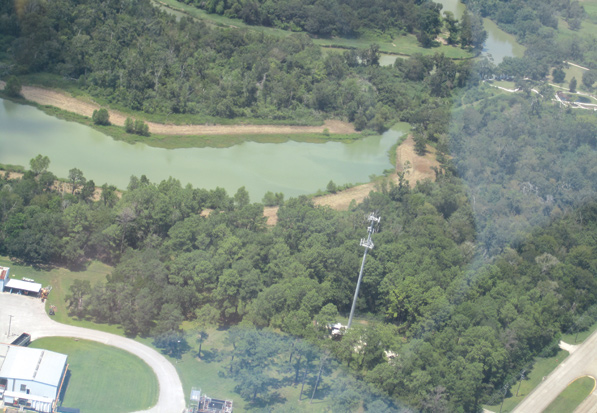
This cell tower marks the crosswind/base turn, with a bright red light to help out at night.
The runway, of course, has vanished.
This is a strange way to fly, in a sort of hybrid visual/instrument world. I keep my eyes outside to maintain situational awareness, with just a glance inside to confirm speed and altitude. Crossing the major road below tells me it is time to turn base-aimed right for the final turn point-a Whataburger restaurant with its red-and-white striped roof, nicely lit up, and open 24 hours a day. Im not that crazy about their burgers, but I do like the paint scheme.
Flaps out in the turn, knobs forward, pumps, and the GUMP check is complete. As I cross over the Whata-checkpoint, a roll to final heading makes the runway appear like one of those magical posters where the dots suddenly coalesce into an image you hadn’t seen before. You have to be lined up to see that you’re lined up.
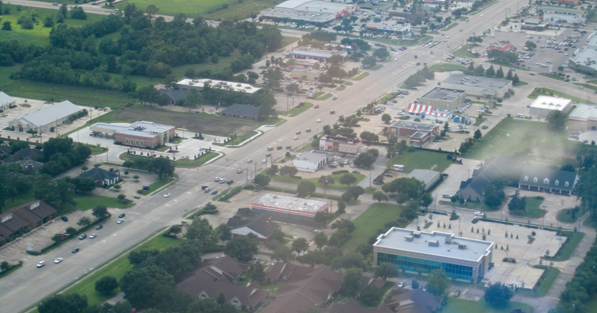
The red-and-white striped roof of the neighborhood Whataburger marks the base to final turn. It is lit up 24 hours a day, making a great night checkpoint.
I slide down the final approach and into the inky black of a coal sack. There isn’t much light on the runway, as folks have mostly gone to bed, their hangars closed, no work lights spilling out into the back yards. There’s no fancy VASI (no home-brewed one, either). You have to know your altitude over the road, and not get too low, or the trees will get you. The runway is much narrower than the lights would indicate-this is no place to try a night landing if you haven’t been here in the daytime. The RVs constant-speed prop allows a steep descent (to stay out of those trees), and the red lights indicating the threshold make a good aim point.
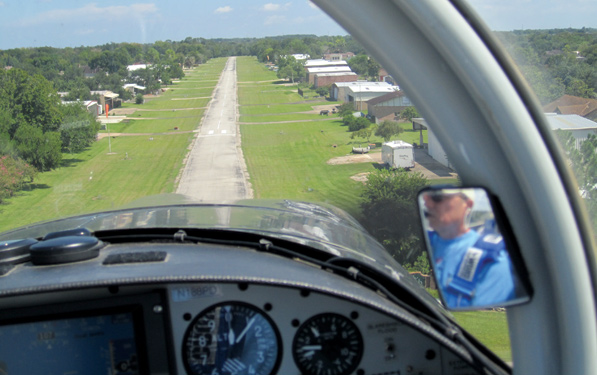
Short final, Runway 11. Familiarizing yourself during daylight hours will help at night.
Oh, yes. It helps to know that the runway isn’t exactly centered between the lights-its offset a couple feet. Did I mention that? But, hey, with an 8-foot gear span, there’s plenty of margin to stay on the asphalt! Finally, pavement appears in the landing lights, and the deep dark well gives way to something more familiar.
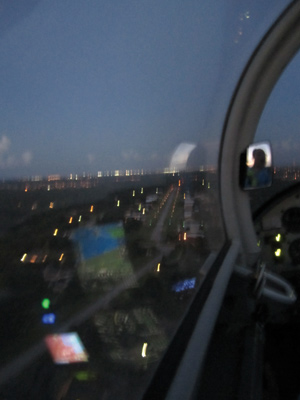
However, landings aren’t over until all the pieces stop moving. In general, folks tend to land hot and long at night, no matter where they are, and at Polly it is no different. Because the runway is short, this means that once you see the pavement, you have precious few seconds to execute a touchdown and bring things under control. Fortunately, winds generally die off after sunset. If they don’t, those shifting crosswinds can make this a doubly tricky place for a taildragger after dark. With little darts here and there, the nose way up and peripheral vision ticking off the houses as they fly by, its no wonder that we all stand on the brakes to make this circus come to a halt as quickly as possible. Suddenly, you realize that you’re stopped with the prop ticking over, and that sound you hear in the headset is your own fast breathing. Those last 10 seconds are worth about an hour in the logbook-at least.
Adding a little power, you roll gently down the runway, trying not to make too much noise. The toughest part is finding your way home if you forgot to leave the back hangar light on. The best part, of course, is that once we shut down, there’s no drive home-just the 20-foot walk from the back of the hangar to the house. Another beautiful evening made possible by the magic of general aviation.





